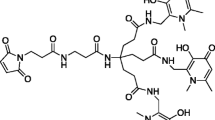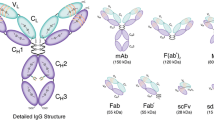Abstract
F(ab′) 2 fragments (at concentrations of 5–30 mg/ml) derived from monoclonal antibodies raised against human prostate specific acid phosphatase were derivatized with a bicyclic anhydride of diethylenetriaminepentaacetic acid (cDTPAA) in the molar ratios of cDTPAA/F(ab′) 2 of 1:1, 5:1, 10:1 or 50:1. The most optimal product, aimed at radioimaging of prostatic cancer was obtained when the antibody fragment concentration was at least 10 mg/ml and the molar ratio of cDTPAA to F(ab′) 2 was 5:1 cDTPAA was added dissolved in dimethylsulfoxide (DMSO). Under these conditions, 1.8–2.2 DTPA molecules/F(ab′) 2 molecule were bound, giving a coupling efficiency of 37%–44%, and the labelling efficiency with 111In (3 mCi/1 mg protein) was 95%±3% (n=7). The antibody fragment completely retained its immunoreactivity measured by radioimmunoassay and showed no aggregation when studied using sodium dodecyl sulfatepolyacrylamide gel electrophoresis (SDS-PAGE).
For evaluation of the degree of conjugation of DTPA to the antibody fragment, a novel technique was developed relying on the use of EuCl3, and the measurement of europium fluorescence employing time resolved fluorometry. Results by EuCl3 labelling were identical to those obtained by the conventional 111InCl3 labelling method.
Similar content being viewed by others
References
Eckelman WC, Karesh SM, Reba RC (1975) New compounds: fatty acid and long chain hydrocarbon derivatives containing a strong chelating agent. J Pharm Sci 64:704–706
Eckelman WC, Paik CH (1986) Comparison of 99mTc and 111In labelling of conjugated antibodies. Nucl Med Biol 13:335–344
Herlyn D, Powe J, Munz D, Alavi A, Herlyn M, Meinken G, Srivastava S, Koprowski H (1986) Radioimmunodetection of human tumor xenografts by monoclonal antibody F(ab′) 2 fragments. Nucl Med Biol 13:401–405
Hnatowich DJ, Layne WW, Childs RL (1982) The preparation and labeling of DTPA-coupled albumin. Int J Appl Radiat Isot 33:327–332
Hnatowich DJ, Childs RL, Lanteigne D, Najafi A (1983) The preparation of DTPA-coupled antibodies radiolabeled with metallic radionuclides: an improved method. J Immunol Methods 65:147–157
Höyhtyä M, Vihko P, Vuolas L, Tryggvason K, Vihko R (1987) High-affinity monoclonal antibodies specific for human prostatic acid phosphatase. Clin Chem 33:103–107
Lowry OH, Rosenbrough NJ, Farr AK, Randall RJ (1951) Protein measurement with the Folin phenol reagent. J Biol Chem 193:265–275
Meares CF, McCall MJ, Rearclarc DT, Goodwin CDA, Diamanti CI, McTigue M (1984) Conjugation of antibody with bifunctional chelating agents: isothiocyanate and bramoacetamide reagents, methods of analysis, and subsequent addition of metal ions. Anal Biochem 142:68–78
Paik CH, Ebbert MA, Murphy PR (1983) Factors influencing DTPA conjugation with antibody by cyclic DTPA anhydride. J Nucl MEd 24:1158–1163
Paik CH, Hong JJ, Ebbert MA, Heald SC, Reba RC, Eckelman WC (1985) Realative reactivity of DTPA, immunoreactive antibody-DTPA conjugates, and nonimmunoreactive antibody-DTPA conjugates towards indium-111. J Nucl Med 26:482–487
Pimm MV, Parkins AC, Baldwin RW (1986) Labelling of monoclonal antibody with metallic radionuclides: preparation of antibody-DTPA conjugates from DTPA anhydride in organic solvent. IRCS Med Sci 14:104–105
Powe J, Pak Ky, Park CH, Steplewski Z, Ebbert MA, Herlyn D, Ernst C, Alavi A, Eckelman WC, Reba RC, Koprowski H (1984) Labeling monoclonal antibodies and F(ab′) 2 fragments with (111In)indium using cyclic DTPA anhydride and their in vivo behaviour in mice bearing human tumor xenografts. Cancer Drug Delivery 1:125–135
Saccavini JC, Bohy J, Bruneau J (1986) Radiolabeling of monoclonal antibodies. Nucl Med Biol 13:191–194
Schroff RW, Stevenson HC (1985) Human immune responses to murine monoclonal antibodies. In: Foon KA, Morgan AC Jr (eds) Monoclonal antibody therapy of human cancer. Nijhoff, Boston, pp 121–138
Sheapard P, Lazarus C, Rowan A, Mistrey R, Maisay M (1986) The radiolabelling of monoclonal antibodies with 111In and their application in vivo for detection of thyroid metastates. Dev Nucl Med 10:530–540
Soini E, Hemmilä I (1979) Fluoroimmunoassay: Present status and key problems. Clin Chem 25:353–361
Vihko P, Schroeder FH, Lukkarinen O, Vihko R (1982) Secretion into and elimination from blood circulation of prostate-specific acid phosphatase, measured by radioimmunoassay. J Urol 128:202–204
Vihko P, Kontturi M, Lukkarinen O, Martikainen P, Pellininiemi L, Heikkilä J, Vihko R (1987) Immunoscintigraphic evaluation of lymph node involvement in prostatic carcinoma. The Prostate 11:51–57
Author information
Authors and Affiliations
Rights and permissions
About this article
Cite this article
Hartikka, M., Vihko, P., Södervall, M. et al. Radiolabelling of monoclonal antibodies: Optimization of conjugation of DTPA to F(ab′) 2-fragments and a novel measurement of the degree of conjugation using Eu(III)-labelling. Eur J Nucl Med 15, 157–161 (1989). https://doi.org/10.1007/BF00254630
Received:
Accepted:
Issue Date:
DOI: https://doi.org/10.1007/BF00254630




